Bowl for Bird Bath Stand: Enhance Your Garden
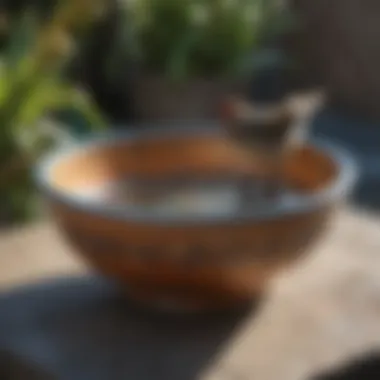
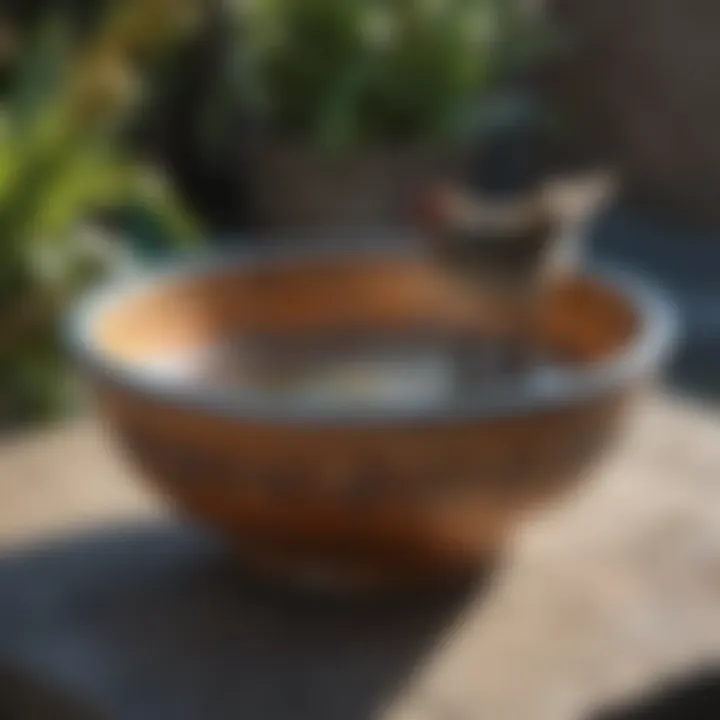
Intro
Creating a bird bath stand in your garden extends beyond functionality; it’s a chance to integrate nature with design. A well-placed bowl can become a striking focal point that enhances not only your outdoor space but also invites wildlife to visit and thrive. Homeowners looking to make their garden a sanctuary for birds often grapple with choosing the right materials and styles. This section lays the groundwork for understanding the essentials in selecting a bowl for your bird bath stand.
Design Inspirations
When diving into the aesthetics of bird baths, it’s beneficial to consider recent trends and classic designs that complement your garden’s character.
Latest Trends in Bath and Garden Design
Current trends in bird bath design lean towards a harmonious blend of nature and artistry. Imagine bowls crafted from natural stones or rustic pottery, standing as a testament to both craftsmanship and environmental consciousness. Many homeowners are drawn to bowls that mimic organic shapes, entwined with natural elements. Examples can be seen in materials such as terracotta, which offer both durability and an earthy appeal.
Color Palettes and Themes
Choosing the right color palette isn't just about preference; it sets the tone for your garden. A vibrant blue or deep green bowl can create a striking visual contrast against a backdrop of foliage, while muted, earthy tones can create a more cohesive, subtle look. It's also advantageous to consider seasonal colors – perhaps a deep, warm hue that reflects the rich autumn tones. Bowls can also be designed to match or complement existing garden furniture, bridging different elements of your outdoor space.
"Creating a bird bath is not merely about providing water; it’s a statement of your connection to nature."
Functional Elements
While aesthetics are crucial, the functionality of your bird bath bowl should not be overlooked. It’s essential that it serves its purpose effectively, ensuring both the comfort and safety of its winged visitors.
Space Optimization Tips
If you’re working with limited space, consider a bird bath bowl that is compact yet impactful. Elevated stands can save on ground space and make the bowl more visible, while larger gardens might accommodate expansive designs or several smaller bowls to attract various bird species. Additionally, strategically positioning your bath near trees or shrubs can offer birds a safe landing during their visits.
Multi-Functional Design Choices
A bird bath bowl can do more than just hold water. Options like integrated feeders or solar-powered fountains can simultaneously entertain birds and elevate the aesthetic appeal. Multifunctional designs can sway bird enthusiasts towards investing in a versatile piece that spares them from having multiple installations. When considering designs, think of how each piece interacts with the rest of your garden – a cohesive aesthetic can enhance the entire environment.
With thoughtful selection and an eye for design, creating a beautiful yet functional bowl for your bird bath stand can transform your garden into a lively haven, encouraging not only avian visitors but also inspiring admiration from fellow nature lovers.
Prologue to Bird Bath Stands
Creating a serene oasis in your garden often starts with bird baths, which capture not only the eye but also invite various wildlife to our vicinity. A properly designed bird bath stand is essential in this decorative yet functional piece. To ones who appreciate the subtle joys of nature, investing in a bird bath stand can transform your outdoor environment into a vibrant sanctuary. These stands are more than just supports; they anchor the overall structure and play a key role in enhancing the aesthetic appeal of your garden.
Importance of Bird Baths in Gardens
Bird baths serve as a crucial lifeline for both local and migratory birds. Providing a reliable water source is especially vital in regions where water might be scant, especially in dry spells. Not only do they hydrate our feathered friends, but they also offer a place for grooming, which is paramount for birds to keep their feathers clean and functional.
In our gardens, bird baths offer a unique opportunity to observe wildlife close-up. Imagine relaxing in your backyard, sipping tea, as you watch finches splashing about or robins searching for insects. This sight makes it clear: bird baths not only enhance the aesthetics of gardens but also foster a connection to the natural world around us.
Understanding Different Designs
Delving into the variety of bird bath stand designs can be quite enlightening. Each design element holds significance not just aesthetically but functionally as well. Some of the common practices include:
- Height and Scale: Choosing the right height ensures birds feel safe while drinking. A lower stature might attract diverse species, while elevated stands could cater to ground feeders.
- Bowl Design: The shape of the bowl can impact water retention and accessibility. Shallow basins are generally favored by smaller birds, while deeper designs cater to others.
- Materials and Artisanship: The substance from which the bird bath bowl is made influences both durability and visual impact. For instance, a ceramic bowl may feature intricate designs, whereas a metal one often provides a contemporary touch.
One must also consider the seasonal changes; certain designs may be more suitable in winter than in summer when birds require a reliable water source the most.
Ensuring the appropriate balance of form and function within your garden will not only sustain wildlife but will also bless your outdoor space with a lively charm. As a homeowner or a gardening enthusiast, making informed choices about your bird bath stands can ensure your garden flourishes with life.
"A garden without birds is like a song without music."
With the myriad options available and the profound effect they have on our environment, understanding these designs is the first step in making your outdoor space a favored spot for feathered visitors.
Materials Used for Bird Bath Bowls
Choosing the right materials for bird bath bowls is essential because it not only influences the aesthetics of your garden but also impacts functionality and maintenance. A bird bath isn’t merely a decorative piece; it serves as a vital resource for our feathered friends. This section will cover different material options, outlining their unique benefits and considerations to help you make an informed choice.
Ceramic Bowls: Aesthetic and Functional Benefits
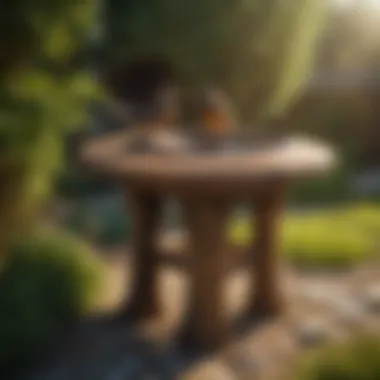
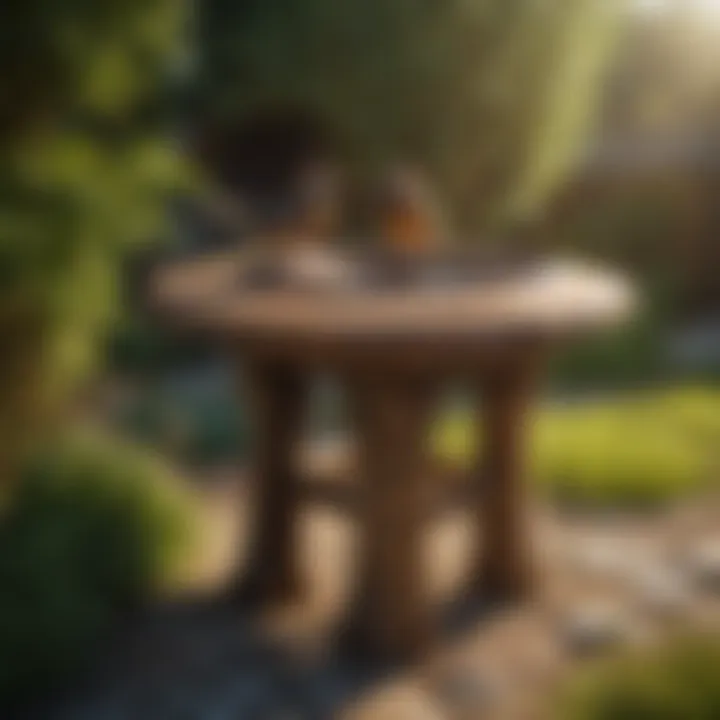
Ceramic bird bath bowls bring a sense of style that few other materials can match. Often available in vibrant colors and intricate patterns, they can easily elevate the visual appeal of your garden. The smooth texture of ceramics is favorable for birds, allowing them to drink and bathe without risk of injury.
However, it is crucial to consider that ceramics can be somewhat delicate. If dropped, they might crack, so placing them securely is important. Despite this minor drawback, they can withstand weather well, provided they are treated properly. Many homeowners choose glazed ceramic bowls that are less prone to absorb moisture, prolonging their life and preventing algae buildup.
- Pros: Aesthetic appeal, smooth texture for birds.
- Cons: Can be fragile, need protective measures during freezing temperatures.
Metal Bowls: Durability and Style
Metal bowls, often made of stainless steel or copper, present a combination of durability and modern appeal. They can withstand harsh weather conditions and are resistant to rust, making them a long-lasting choice. Metal bowls typically offer a sleek, contemporary look, fitting well into modern garden themes.
However, it’s essential to choose the right type of metal. For instance, untreated metals can heat up significantly in the sun, which may not be comfortable for birds. Additionally, sharp edges can pose a risk, so it’s vital to ensure that metal bowls are well-finished. Installing a metal bowl can often lend an industrial vibe to your garden, striking a pleasing balance with natural elements like plants and trees.
- Pros: Highly durable, easy to clean.
- Cons: Can get hot, risk of sharp edges.
Concrete and Stone Options: Natural Appeal
Concrete and stone bird bath bowls are the ultimate in durability. They can withstand the test of time, creating a robust presence in your garden. These materials often blend seamlessly with natural landscapes, contributing to a rustic or classic aesthetic. A concrete bowl can be quite heavy, which may prevent it from being easily toppled by winds or curious animals.
Yet, while they offer a natural aesthetic, it’s important to note that concrete may absorb water, leading to algae growth if not regularly cleaned. Stone options, such as granite or slate, are often visually appealing, with irregular textures that bring an organic feel to the outdoor space. These bowls can also provide warmth in colder months, drawing birds as a water source.
- Pros: Extremely durable, blends with nature.
- Cons: Heavy to move, potential for algae if not maintained.
Choosing the right material for your bird bath bowl significantly influences not only aesthetics but also the safety and comfort of visiting birds.
Design Considerations for Your Bird Bath Bowl
When setting up your bird bath, the bowl plays a star role in not just attracting feathered friends but also in enhancing your garden’s appeal. It's crucial to consider design elements that go beyond mere aesthetics. A well-thought-out bowl design can attract more birds, fit seamlessly into your garden, and add to the overall landscape design. Focusing on size, depth, color, texture, and water level management ensures that your bird bath is both functional and visually appealing.
Size and Depth: Finding the Right Balance
Choosing the right size and depth for your bird bath bowl is vital. If the water is too shallow, birds may find it less inviting, while too deep can deter small species from taking a dip. A good rule of thumb is aiming for the bowl to be around two to three inches deep. This provides ample water for various birds to enjoy without the fear of drowning.
The diameter of the bowl should also be considered. A wider basin allows more birds to bathe simultaneously, which can turn your garden into a bustling hub of activity. On the other hand, a smaller bowl can create intimacy, attracting more timid species.
Color and Texture Choices: Enhancing Aesthetics
Color and texture play an essential part in how your bird bath is perceived, both by you and by the birds. Natural colors, such as earthy greens and browns, tend to blend in nicely with garden settings. Meanwhile, brighter colors can attract birds who may be drawn to lively appearances.
Textures are just as significant. A textured surface mimics natural elements like pebbles or tree bark, encouraging birds to feel safe while they perch and bathe. Alternatively, smooth bowls are easier to clean, which is an important consideration for maintenance.
"In gardens, a well-placed birdbath can often be the centerpiece that ties the whole scene together. Both its color and texture should enhance rather than clash with surrounding flora."
Importance of Water-Level Management
Water-level management in your bird bath bowl cannot be overlooked. This involves not only ensuring that the water is clean but also that the water level is maintained at an appropriate depth. It also helps to keep the water moving slightly, if possible. Water that’s stagnant can become a mosquito breeding ground and possibly deter birds looking for a refreshing drink or bath.
A simple solution is to check the bowl regularly, topping off the water as needed. Adding a small fountain can also create a gentle flow, making it more irresistible. Regularly changing the water will keep it clean and ensure it’s always appealing to the birds.
Crafting the perfect design for your bird bath bowl entails weaving together these considerations for size and depth, color and texture, and effective water management. By doing so, you're not just creating a water source for the birds; you're planting a lively hub of nature’s beauty in your own backyard.
Constructing a Bird Bath Stand
Building a bird bath stand is not only a fun project but also a vital aspect of creating a welcoming spot for birds in your garden. A well-constructed stand represents stability, ensuring that your bird bath remains accessible and functional through various weather conditions. The stand should match both the design of your bowl and the overall aesthetic of your landscape, enhancing the beauty of your outdoor space while serving a practical purpose.
Choosing the Right Base for Stability
When thinking about the base of your bird bath stand, stability is key. Without a strong foundation, the entire structure could topple over easily, leaving your feathered friends without their much-needed water source. It's advisable to consider materials that can withstand outdoor elements.
- Wood: Treated lumber or rot-resistant varieties like cedar work well but may require occasional maintenance or sealing because they can degrade over time.
- Metal: Materials like galvanized steel or wrought iron offer durability while infusing a modern look. Their sturdiness will prevent wobbling or tipping.
- Stone or Brick: A base made from heavy stone can provide excellent stability but may require more effort to set up. Additionally, these materials can seamlessly blend into a natural environment, harking back to a classic garden aesthetic.
Consider the height of the base too; it should be comfortably accessible for birds yet not so high that it makes them feel exposed or vulnerable. The goal is to create a safe haven for these creatures, which often favor lower, sheltered places.
DIY Options vs. Store-Bought Solutions
This is where personal preference and practicalities come into play. Both DIY options and store-bought solutions have their respective merits and drawbacks.
- DIY Options: If you're handy with tools, crafting a stand yourself can be immensely satisfying. You have the freedom to choose materials and customize the design to match your specific preferences. Plus, you might find that engaging with a project from scratch fosters a deeper connection to your garden. For example, you could repurpose old wooden pallets or even build using leftover bricks from landscaping projects.
- Store-Bought Solutions: On the flip side, purchasing a ready-made stand can save time and ensure consistency of construction quality. Many options available today are designed with aesthetics and functionality in mind, so it's worth exploring local gardening stores or online retailers to find something that fits your vision.
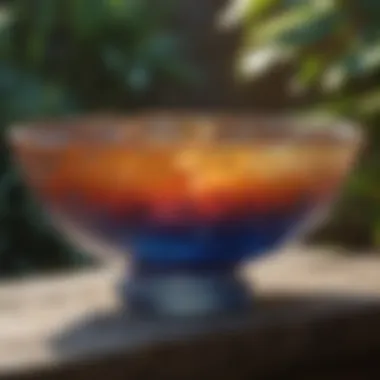
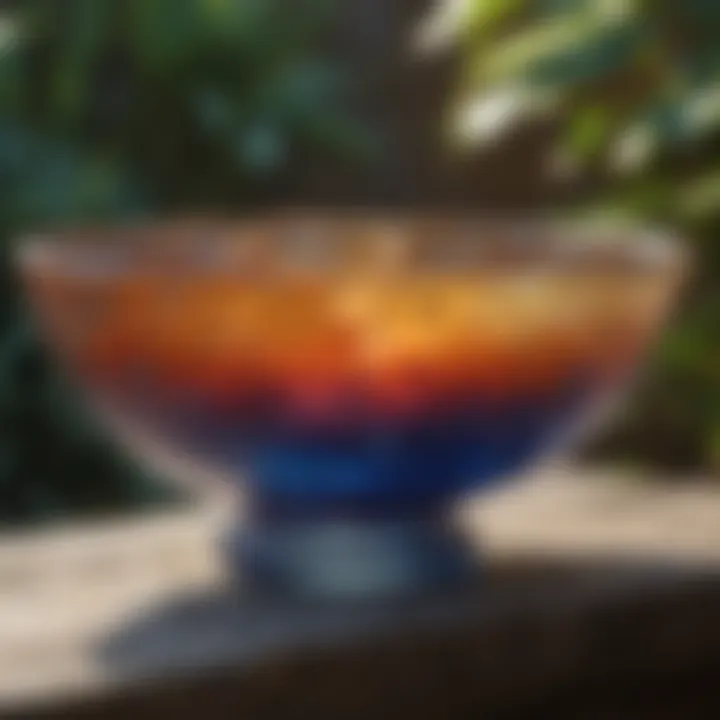
Ultimately, the choice comes down to what suits your style, skills, and schedule.
Securing the Bowl to the Stand: Techniques
Once you've decided on a stand, the next step is to securely attach the bowl. This ensures that it doesn't shift or fall, particularly during windy days or when birds land on its edge. Here are several techniques you could consider:
- Screw and Bolt Method: Using corrosion-resistant screws, attach the bowl directly to the stand. This method is one of the most reliable and can easily be undone if you wish to switch out bowls or designs in the future.
- Adhesive Sealants: Marine-grade adhesives are another option that can bond the bowl to the stand with incredible strength. They handle moisture well; however, do keep in mind that this could be a permanent solution.
- Bracket Hardware: Using brackets gives an added layer of security. Metal brackets secured into place will provide a supportive cradle for the bowl, preventing it from moving around.
Whatever method you choose, ensure that it's both stable and maintains the aesthetic appeal of your bird bath set up.
A well-constructed bird bath stand not only enhances your garden but fosters a nurturing environment for birds, encouraging them to visit regularly, thereby boosting your outdoor experience.
By putting thought into the construction of your bird bath stand, you're setting a strong foundation, quite literally, for a beautiful wildlife-friendly space.
Maintenance of Bird Bath Bowls
Maintaining bird bath bowls is a pivotal aspect often overlooked by many enthusiasts. It’s not just about aesthetics; it's about creating a sustainable environment for bird life. Regular upkeep helps to ensure that the bird bath remains inviting and free from harmful substances that could deter our feathered friends or, worse, make them ill. Beyond merely keeping the bowl clean, understanding the specific maintenance required at different times of the year can safeguard your investment and prolong its life in your garden.
Regular Cleaning Practices
To keep your bird bath bowl in prime condition, regular cleaning is essential. Debris, algae, and ministering pests could quickly turn your bird haven into a disease-ridden pool. Here are some steps to follow:
- Frequency: Ideally, give your bird bath a thorough cleaning at least once a week, especially if you live in an area with hot temperatures where algae might flourish.
- Cleaning Solution: A simple and effective solution is a mix of vinegar and water. It’s strong enough to tackle grime yet gentle on the environment. Mix one part vinegar to nine parts water for a natural cleaner.
- Scrubbing: Use a non-abrasive sponge or cloth to scrub the bowl. Avoid steel wool or harsh brushes, as these can scratch the surface and make it more prone to collecting dirt over time.
- Rinsing: After scrubbing, rinse the bowl thoroughly with clean water to ensure no cleaning solution remains, which could harm the birds.
- Check the Stand: While cleaning the bowl, inspect the stand for stability and signs of wear. A solid base is vital for preventing spills and accidents.
"A clean bird bath isn’t just a beauty mark for your yard, it's a vital piece in the puzzle of wildlife rescue."
Winter Preparations: Protecting Your Investment
As the chilly months approach, fortifying your bird bath bowl becomes paramount. Birds still need water throughout winter, but the challenges posed by the seasonal changes call for specific strategies to keep their water supply accessible. Here’s how to prepare:
- Inspect for Cracks: Before winter sets in, examine your bird bath for any cracks or weaknesses. Small flaws could worsen with freezing temperatures. Consider patching these with a suitable waterproof sealant.
- Heat Sources: If you want to continue offering a water source, install a bird bath heater. These devices help in preventing the water from freezing, ensuring that the birds have open access to hydration during the colder months.
- Drain and Clean: If freezing temperatures are on the horizon, it’s a good idea to drain your bowl. Clean it, and store it in a safe area like a shed or garage for the winter months. This helps prevent water from causing cracks due to expansion when it freezes.
- Consider Migration Patterns: Be aware of the bird species in your area. Some birds migrate, while others do not. Even a few birds will still appreciate the effort if you provide fresh water.
Preparing your bird bath for winter is about protecting both your investment and the welfare of the birds that visit. Pay attention during transitions in weather to ensure that your garden remains a welcoming sanctuary.
Enhancing the Bird Bath Experience
Creating a bird bath is more than just placing a bowl of water in your yard; it’s about crafting an inviting space that uplifts the entire garden environment. A well-designed bird bath can attract various bird species, while also offering visual delight to the home. Therefore, enhancing your bird bath experience is crucial to ensure that both the birds and the garden thrive in harmony.
Incorporating Plants and Surroundings
When it comes to integrating your bird bath into its surroundings, plants play a pivotal role. Placing your bird bath near strategically chosen plants not only beautifies the area, but also provides birds with natural cover from predators. Consider using shrubs or small trees nearby; these established plants offer shade for birds, making your yard more appealing.
A riot of colors around the bird bath can make a stark bowl look even more enticing. Consider plants like ornamental grasses or flowering bushes, which attract not just the birds with their seeds and flowers, but also butterflies and other pollinators. Furthermore, include a few native plants that provide food and shelter to the birds in the area. By creating a layered landscape, you encourage a broader spectrum of birdlife and create a lively habitat.
Choosing the Right Location in Your Yard
The location of your bird bath can make or break its usage. Positioning your bird bath in a shady spot is generally preferred, as it helps keep the water cool and fresh, especially during the hotter months. But if you place it too deep in foliage, birds may be hesitant to approach. Finding that sweet spot can sometimes feel like hunting for gold in a haystack.
Take into account the vantage points from which birds can see potential dangers, such as cats or other wildlife. Opt for a location that allows them to spot threats while enjoying a leisurely drink or splash. A gentle slope or flat area is often ideal, facilitating their landing and gaining access to water. Mark different potential sites in your yard, then stand back and observe bird activity. An attentive eye can often guide you in making the best choice.
Adding Features: Fountains and Water Movement
One can't underestimate the ever-poignant allure of moving water. Birds are naturally drawn to the sound and sight of water in motion, which is why incorporating features like fountains can significantly enhance the bird bath experience. The splashes and ripples created by flowing water can entice even the shyest of feathered visitors.
You don’t have to go overboard; even a simple fountain can suffice. Choose low-maintenance solar-powered options, which not only help keep your water fresh but also minimize electricity costs. Besides, adding an adjustable water flow allows you to control splashes and attract a broader range of bird species.
Consider elements like stones or logs around the fountain area, mimicking a natural setting where birds feel safe from owls and other predators. These additions can provide perches or landing spots that make your bird bath more accessible to them.
Improving the overall bird bath experience truly takes a little bit of effort mixed with creativity. Whether it’s through thoughtful positioning, style enhancements with plants, or dynamism brought through water features, each small change can lead to a lively and beneficial space for both you and the birds.
Bird Bath Bowl Styles and Trends
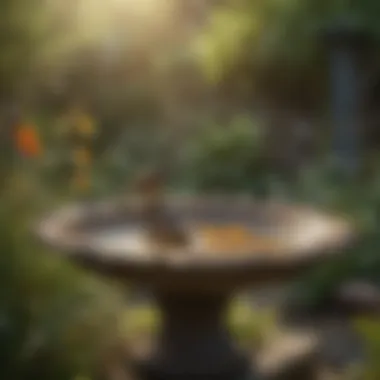
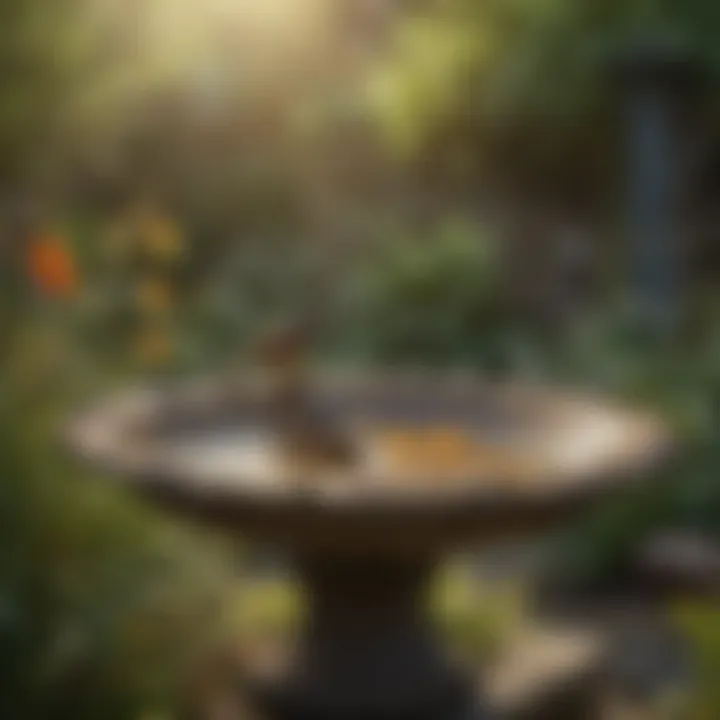
When it comes to creating inviting habitats in your garden, the style of your bird bath bowl plays a crucial role. Not only does it serve a practical purpose by providing water for our feathery friends, it also contributes significantly to the overall aesthetic of your outdoor space. As trends in garden design evolve, homeowners and garden enthusiasts alike are increasingly aware of how their choices can impact both wildlife interaction and the beauty of their surroundings. In this section, we will explore two primary design approaches for bird bath bowls: contemporary and classic/rustic styles. Each has its own unique appeal and considerations, ensuring there's something for every taste.
Contemporary Design Approaches
Contemporary bird bath bowl styles lean towards minimalism and innovation. They often feature sleek lines, geometric shapes, and materials that blend seamlessly with modern landscaping. There are several key elements to consider:
- Materials: Contemporary designs may be crafted from durable materials like glass, stainless steel, or even recycled composites, which exude a modern vibe while ensuring longevity.
- Shape: Expect to see asymmetric shapes or rounded forms that provide an elegant touch. These bowls are not just functional, but they make a statement as artistic elements in your garden.
- Color Palette: Soft, muted tones or even stark monochromes are common. Bright colors tend to take a backseat, allowing the bowl to enhance rather than overtake the natural landscape.
- Integration: A contemporary bird bath often fits well within themed outdoor spaces; think urban gardens or minimalist modern homes. They may even feature integrated technology like solar-powered pumps for water circulation.
A contemporary bird bath can elevate the look of your garden, making it not just a space for wildlife but a carefully curated outdoor experience.
Classic and Rustic Styles
In stark contrast, classic and rustic bird bath styles carry a sense of traditional charm and warmth. These designs often evoke nostalgia and connect homeowners with nature in a way that feels timeless. Here are some aspects that make these styles appealing:
- Materials: Clay, ceramics, or aged stone are frequently used. The natural textures and earthy colors blend well with plants and trees.
- Design Features: Curved shapes, intricate carvings, and hand-painted designs characterize classic and rustic options. Look for ornamental bases that reflect old-world craftsmanship.
- Aging Characteristics: Weathered finishes or patinas add rustiness, giving the impression that the bird bath has been part of the garden for generations.
- Surrounding Garden Design: These bowls are often paired with other rustic elements, such as wooden fences or stone pathways, to create a cohesive look. They enhance the charm of wildflower gardens or cottage-style landscapes.
Adopting classic styles not only beautifies your garden, but also invites various bird species that find comfort in familiar, natural settings.
A bird bath's aesthetic can transform garden spaces from ordinary to extraordinary, merging function with art effortlessly.
By considering these different styles, homeowners can choose a bird bath bowl that echoes their taste and enhances the overall narrative of their outdoor sanctuaries. Whether drawn to modern minimalism or the comforting nostalgia of rustic charm, the choice of a bird bath bowl can significantly impact the ambiance and allure of any garden.
Encouraging Bird Species to Visit
Creating a garden space that attracts various bird species is essential for any bird bath enthusiast. It’s not just about providing a pretty bowl filled with water; it’s about fostering a welcoming environment that engages feathery visitors. The right arrangements can lead to a vibrant ecosystem right in your backyard, providing an excellent view into the lives of these delightful creatures.
Selecting Appropriate Bird Feeders and Baths
Choosing the right bird feeders and baths comprises important steps in ensuring that birds are drawn to your garden. Different species have unique needs, so understanding their preferences is key. For instance, hummingbirds are attracted to nectar, and a well-placed feeder with a nectar solution can be a game changer.
- Types of Feeders:
- Watering Solutions:
- Strategic Placement: Consider placing feeders within sight of your birdbath. It invites birds to hop from one spot to another with ease.
- Seed Feeders: Often made of plastic or metal, they are simple to fill and clean. Sunflower seeds attract many species.
- Suet Feeders: Ideal for attracting insect-eating birds, suet brings in woodpeckers and nuthatches.
- Shallow bowls encourage birds to hop in for a quick bath, while deeper ones benefit those that prefer a good splash.
Creating Safe Environments
Birds thrive in environments that feel safe. To foster this sense of security in your garden, a few considerations are crucial:
- Shelter from Predators:
Dense shrubs and trees can offer necessary cover. Position your birdbath near some greenery, giving birds an escape route if need be. - Observing Disturbances: Locations too close to human activities or erratic pets may frighten birds away. Consider quieter zones in your yard for birdbaths and feeders.
- Natural Landscaping: Native plants can attract insects that serve as food for birds, creating a balanced ecosystem. It’s about making your yard inviting and nurturing.
As noted by experts, "A little bit of effort in arranging feed and shelter can amplify your chances of drawing in unique bird species."
In summary, attracting a variety of bird species involves thoughtful selection of feeders and baths while ensuring a safe haven for them to visit. Invest time in observing the types of birds in your area and tailor your garden setup to meet their needs.
End: The Value of Bird Bath Bowls
As one reflects on the significance of bird bath bowls within the realm of garden décor, one can’t help but notice that they are more than just ornamental fixtures. These bowls serve practical purposes while enhancing the overall appeal of outdoor spaces. Offering a reliable source of hydration to local birds, they create inviting moments where nature and human creativity intertwine.
Impact on Garden Aesthetics and Wildlife
Bird bath bowls contribute to gardens as important focal points that evoke tranquility and charm. Imagine a vibrant garden, flowers in full bloom, butterflies fluttering from petal to petal, and then a bird bath glistening under the sun, drawing the eye. In terms of design, the shape, color, and material of the bowl can harmonize with the surrounding flora, making for a unified and captivating landscape.
- Providing sustenance to wildlife, these bowls encourage birds to frequent the space, creating a lively atmosphere filled with chirps and fluttering wings. Species such as hummingbirds, finches, and sparrows not only beautify the garden but also play vital roles in pollination and insect control.
An effective way to enhance wildlife attraction is by carefully selecting plants that offer snacks for the birds. Native flora will not only create a safer territory for avian visitors but also establish a naturally beneficial ecosystem. A well-situated bird bath can become the heart of this interaction, attracting diverse wildlife and featuring their enchanting behaviors.
Final Thoughts on Design and Functionality
In the end, the convergence of design and functionality cannot be overlooked. Choosing the right bird bath bowl necessitates an understanding of how form influences function. Each bowl's depth, size, and material determine the ease with which birds utilize them. Shallow, wide bowls may attract more birds while deeper designs will need careful water management.
Moreover, the design must speak to the homeowner's vision. A rustic stone bowl may fit well among naturalistic gardens, whereas a sleek ceramic piece could complement a modern landscape. The intention behind placement, the visual flow from one space to another, and the purpose of creating a havens for wildlife all factor into this decision.
Ultimately, the integration of bird bath bowls into your garden not only elevates aesthetics but also nurtures avian life that enriches your outdoor experience. Whether opting for simplicity or intricate designs, it’s essential to remember that beauty thrives when it incorporates both nature and personal flair into the picture.
Considering the impact on the overall garden experience, investing time and thought into the selection of a proper bird bath bowl can yield profound results. With proper positioning and care, a bird bath can become a centerpiece in the daily rhythm of life around one’s home.















